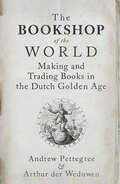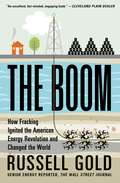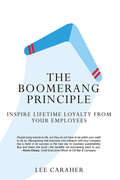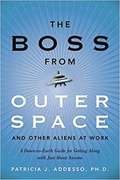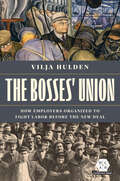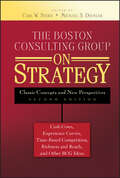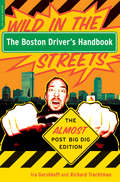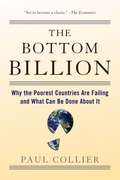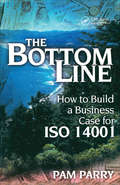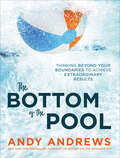- Table View
- List View
The Book on Rental Property Investing: How to Create Wealth and Passive Income Through Intelligent Buy & Hold Real Estate Investing!
by Brandon Turner<p>In The Book on Rental Property Investing, real estate investor and co-host of the BiggerPockets Podcast Brandon Turner has one goal in mind: to give you every strategy, tool, tip, and technique needed to become a millionaire rental property investor―while helping you avoid the junk that pulls down so many wannabes! <p>Written for both new and experienced investors, this book will impart years of experience through the informative and entertaining lessons contained within. You’ll find practical, up-to-date, exciting strategies that investors across the world are using to build wealth and significant cash flow through rental properties. </p>
The Book on Winning the Game of Life
by Kevin AbdulrahmanLife is a game, yet most people don’t know how to play to win. Most people work very hard and try to emulate other successful people only to fail miserably. As Kevin puts it, “Most people lack the secret weapons.” In The Book, Kevin will help expose the secret weapons so that you can then take them on and develop to a point where you become a master of the weapons. It’s only then that you will have everything you want in your life. What makes successful people good at whatever they put their minds to? What makes winners win? What makes a small percentage of people live the ultimate lifestyle and enjoy happiness? All that is revealed in The Book on Winning the Game Of Life.
The Book-Keeper and American Counting-Room Volume 1: July, 1880–December, 1881 (Routledge Library Editions: Accounting History #9)
by Richard P. BriefThis book, first published in 1989, contains reprints of the early periodical on accounting, The Book-Keeper. It dealt with ‘historical reviews of methods and systems in all ages and by all nations. Elucidations of accounts, introducing new and simplified features of accounting. Problems from the counting-room discussed and explained. Instructive notes upon plans and methods of book-keeping in every department of trade, commerce and industry.’ The journal is a primary source for students interested in the history of accounting.
The Book-Keeper and American Counting-Room Volume 2: January, 1882–June, 1883 (Routledge Library Editions: Accounting History #10)
by Richard P. BriefThis book, first published in 1989, contains reprints of the early periodical on accounting, The Book-Keeper. It dealt with ‘historical reviews of methods and systems in all ages and by all nations. Elucidations of accounts, introducing new and simplified features of accounting. Problems from the counting-room discussed and explained. Instructive notes upon plans and methods of book-keeping in every department of trade, commerce and industry.’ The journal is a primary source for students interested in the history of accounting.
The Book-Keeper and American Counting-Room Volume 3: July, 1883–December, 1883 (Routledge Library Editions: Accounting History #11)
by Richard P. BriefThis book, first published in 1989, contains reprints of the early periodical on accounting, The Book-Keeper. It dealt with ‘historical reviews of methods and systems in all ages and by all nations. Elucidations of accounts, introducing new and simplified features of accounting. Problems from the counting-room discussed and explained. Instructive notes upon plans and methods of book-keeping in every department of trade, commerce and industry.’ The journal is a primary source for students interested in the history of accounting.
The Book-Keeper and American Counting-Room Volume 4: January, 1884–December, 1884 (Routledge Library Editions: Accounting History #12)
by Richard P. BriefThis book, first published in 1989, contains reprints of the early periodical on accounting, The Book-Keeper. It dealt with ‘historical reviews of methods and systems in all ages and by all nations. Elucidations of accounts, introducing new and simplified features of accounting. Problems from the counting-room discussed and explained. Instructive notes upon plans and methods of book-keeping in every department of trade, commerce and industry.’ The journal is a primary source for students interested in the history of accounting.
The Bookshop of the World: Making and Trading Books in the Dutch Golden Age
by Andrew Pettegree Arthur der WeduwenThe untold story of how the Dutch conquered the European book market and became the world’s greatest bibliophiles.The Dutch Golden Age has long been seen as the age of Rembrandt and Vermeer, whose paintings captured the public imagination and came to represent the marvel that was the Dutch Republic. Yet there is another, largely overlooked marvel in the Dutch world of the seventeenth century: books.In this fascinating account, Andrew Pettegree and Arthur der Weduwen show how the Dutch produced many more books than pictures and bought and owned more books per capita than any other part of Europe. Key innovations in marketing, book auctions, and newspaper advertising brought stability to a market where elsewhere publishers faced bankruptcy, and created a population uniquely well-informed and politically engaged. This book tells for the first time the remarkable story of the Dutch conquest of the European book world and shows the true extent to which these pious, prosperous, quarrelsome, and generous people were shaped by what they read.“Book history at its best.” —Robert Darnton, New York Review of Books“Compelling and impressive.” —THES (Book of the Week)“An instant classic on Dutch book history.” —BMGN - Low Countries Historical Review
The Boom: How Fracking Ignited the American Energy Revolution and Changed the World
by Russell GoldThe “best all-around book yet on fracking” (San Francisco Chronicle) from a Pulitzer Prize finalist: “Gold's work is a tour de force of contemporary journalism” (Booklist).First invented in 1947, hydraulic fracturing, or fracking, has not only become a major source of energy, it is changing the way we use energy, and the energy we use. It is both a threat and a godsend for the environment, and it is leading the revival of manufacturing in the United States. A definitive narrative history, The Boom follows the twists and turns in the development and adoption of this radical technology. It is a thrilling journey filled with colorful characters: the green-minded Texas oilman who created the first modern frack; a bare-knuckled Oklahoman natural gas empire-builder who gave the world an enormous new supply of energy and was brought down by his own success and excesses; an environmental leader whose embrace of fracking brought an end to his public career; and an aging fracking pioneer who is now trying to save the industry from itself. A fascinating and exciting exploration of one of the most controversial and promising sources of energy, The Boom “brings new clarity to a subject awash in hype from all sides…a thoughtful, well-written, and carefully researched book that provides the best overview yet of the pros and cons of fracking. Gold quietly leads both supporters and critics of drilling to consider other views” (Associated Press).
The Boomerang Principle: Inspire Lifetime Loyalty from Your Employees
by Lee CaraherIt is rare today for employees to stay with one organization for the long tenures that were the norm before the Great Recession. In fact, "job hopping" is the new norm, especially for Millennials. In The Boomerang Principle, companies learn how to leverage this fact rather than fear it. By engendering a lifetime of loyalty from former employees, leaders can see them "return" in the form of customers, partners, clients, advocates, contractors, and even returning employees.Author Lee Caraher has built several companies and managed many Millennials along the way. In her first book, Millennials & Management, she shared her wisdom on how to get an intergenerational workforce to contribute to the larger goals of the organization. In this follow-up book, she shifts the emphasis to creating valuable, long-lasting relationships with your employees to ensure they remain your biggest fans, even if they leave the company.The Boomerang Principle is a pragmatic answer to the outdated corporate mindset around employee turnover. Instead, it shifts the focus to creating lifetime loyalty from your alumni who will bring back business again and again.
The Borders of the European Union in a Conflictual World: Interdisciplinary European Studies
by Lars Oxelheim Anna Michalski Antonina Bakardjieva Engelbrekt Per EkmanThis open access book examines the implications for the EU of a radically changed international context characterized by systemic rivalry, competition over norms and regulations, and growing strategic tension. Globalization that once tied national economies together and internationalized social phenomena, such as education, research and innovation, and tourism, has gone in reverse. An opposite trend is driving the world into distinct spheres of competing models of governance, regulation, technological development, and communication. Facing the most extensive rupture of economic and inter-state relations since the onset of the Cold War, the management of the EU’s internal and external borders is taking on a completely new meaning. The open access book brings together scholars from economics, law, and political science to provide up dated assessments and policy advice on the insecurity in the neighborhood and war in Ukraine, the EU’s role in the future European security architecture,weaponized energy dependence, and the global competition on norms.
The Boss Has the Wrong Idea: Confidential Role Material for Julia Smith
by Katherine Coffman Kathleen L. McGinn Katherine Chen Judith A. Clair"The Boss Has the Wrong Idea" is a two-person conversation exercise in which an MBA student seeks advice from a mentor in her field about how to handle an incident of workplace sexual harassment. The case consists of two confidential role materials: a role for the student, Julia, which describes her troubling experience with her boss during a summer internship, and a role for the senior mentor, Lee, which mentions that Julia is hoping to receive advice from him about a complicated situation. Julia's story presents a richly detailed, first-hand (fictionalized) account of a young woman's experience in a male-dominated, competitive firm. Her narrative provides a compelling representation of the nuances and challenges associated with experiencing sexual harassment in the workplace. Because it is written as a conversation exercise, the case provides students, faculty, and administrators with not only the opportunity to think about how to address (and prevent) sexual harassment within their own organizations, but also with the opportunity to engage in the difficult conversations that these issues demand. How can we best offer support and guidance? What are strategies for effective listening, question asking, and advice-giving in emotionally-charged and sensitive situations?
The Boss Has the Wrong Idea: Confidential Role Material for Lee Clancy
by Katherine Coffman Kathleen L. McGinn Katherine Chen Judith A. Clair"The Boss Has the Wrong Idea" is a two-person conversation exercise in which an MBA student seeks advice from a mentor in her field about how to handle an incident of workplace sexual harassment. The case consists of two confidential role materials: a role for the student, Julia, which describes her troubling experience with her boss during a summer internship, and a role for the senior mentor, Lee, which mentions that Julia is hoping to receive advice from him about a complicated situation. Julia's story presents a richly detailed, first-hand (fictionalized) account of a young woman's experience in a male-dominated, competitive firm. Her narrative provides a compelling representation of the nuances and challenges associated with experiencing sexual harassment in the workplace. Because it is written as a conversation exercise, the case provides students, faculty, and administrators with not only the opportunity to think about how to address (and prevent) sexual harassment within their own organizations, but also with the opportunity to engage in the difficult conversations that these issues demand. How can we best offer support and guidance? What are strategies for effective listening, question asking, and advice-giving in emotionally-charged and sensitive situations?
The Boss from Outer Space and Other Aliens at Work: A Down-to-earth Guide For Getting Along With Just About Anyone
by Patricia J. Addesso, Ph.D.Anyone who works in an office probably has to deal with at least some people who are so different they might as well be from another planet. These differences can lead to conflict or -- if handled properly -- to a greater appreciation of others and a more productive workplace. The secret to getting along lies in understanding the different personality traits people exhibit and how to relate to them. The author identifies 11 traits that can make work relationships difficult, which she compares to the planets (plus the moon and the sun), including: * Saturn, with its distinctive rings, symbolizes how comfortable one is being different, and shows whether one is more of a conformist or experimenter * Jupiter, made up mostly of gases, has a bubbly spirit, and signifies one’s level of optimism * Earth (as in "down to Earth") indicates whether someone is grounded, or has one’s "head in the clouds." Fun and easy to read, yet packed with realistic strategies, this very human guide will help anyone on the planet get along with even their most difficult coworker.
The Boss of You: Everything A Woman Needs to Know to Start, Run, and Maintain Her Own Business
by Lauren Bacon Emira MearsFemale entrepreneurs are a growing force to be reckoned with. Each year, more and more women take the initiative and start their own business ventures-at twice the rate of men. Women continue to reshape the business world with innovative models, both large and small. So why is there a lack of clear-cut, expert advice aimed at this dynamic female audience?In The Boss of You, Emira Mears and Lauren Bacon, founders of Raised Eyebrow Web Studios Inc. and co-editors of the well-known webzine Soapboxgirls, set out to answer this question. As intelligent entrepreneurs and straightforward writers, Emira and Lauren offer insight into beginning-and sustaining-small businesses from the female perspective. Peppered with stories from women who have been there, from cautionary tales to success stories, The Boss of You provides readers with real advice and career options that will allow them to live their values and achieve their own version of work-life balance.Whether you are an established professional or an entrepreneurial newbie, The Boss of You is the definitive guidebook for starting, maintaining, and enjoying your own business.
The Boss: Von Bruce Springsteen Führungsstärke lernen
by Peter AschenbrennerViele Führungskräfte sind ihrer Führungsrolle nicht gewachsen. Und Unternehmen kostet das Millliarden. Das Buch von Dr. Peter Aschenbrenner ist ein Leitfaden für Führungskräfte und alle, die es werden wollen oder sollen. Es ist Ratgeber und zugleich Hilfestellung, um die Führungsqualität zu erhöhen. Hier kommt Bruce Springsteen als Führungskraft ins Spiel. Für den leidenschaftlichen Bruce-Springsteen-Fan Peter Aschenbrenner ist der "Boss" ein ideales Vorbild für Führungsstärke. Von der Art, wie er mit seiner Band zum Beispiel auf der Bühne agiert, können sich Führungskräfte in Unternehmen etwas abschauen. Das heißt, die sich überall durchziehende musikalische Metapher mit realen Erlebnissen des Autors aus seinen 137 Bruce-Springsteen-Konzertbesuchen holen den Leser in eine nahbare Welt. Entwicklungsfelder werden sichtbar, um als Führungskraft professioneller, entspannter, gelassener und gesünder zu arbeiten. Das Buch transferiert auf leicht umsetzbare Art Theorie in die Praxis und fördert die Leichtigkeit in der Führung. Darüber hinaus ermöglicht es noch die Beantwortung einer Frage, mit der sich fast jede Führungskraft einmal konfrontiert sieht: "Will ich das wirklich?"
The Bosses' Union: How Employers Organized to Fight Labor before the New Deal (Working Class in American History)
by Vilja HuldenAt the opening of the twentieth century, labor strife repeatedly racked the nation. Union organization and collective bargaining briefly looked like a promising avenue to stability. But both employers and many middle-class observers remained wary of unions exercising independent power. Vilja Hulden reveals how this tension provided the opening for pro-business organizations to shift public attention from concerns about inequality and dangerous working conditions to a belief that unions trampled on an individual's right to work. Inventing the term closed shop, employers mounted what they called an open-shop campaign to undermine union demands that workers at unionized workplaces join the union. Employer organizations lobbied Congress to resist labor's proposals as tyrannical, brought court cases to taint labor's tactics as illegal, and influenced newspaper coverage of unions. While employers were not a monolith nor all-powerful, they generally agreed that unions were a nuisance. Employers successfully leveraged money and connections to create perceptions of organized labor that still echo in our discussions of worker rights.
The Boston Consulting Group on Strategy: Classic Concepts and New Perspectives
by Carl W. Stern Michael S. DeimlerA collection of the best thinking from one of the most innovative management consulting firms in the world For more than forty years, The Boston Consulting Group has been shaping strategic thinking in business. The Boston Consulting Group on Strategy offers a broad and up-to-date selection of the firm's best ideas on strategy with fresh ideas, insights, and practical lessons for managers, executives, and entrepreneurs in every industry. Here's a sampling of the provocative thinking you'll find inside: "You have to be the scientist of your own life and be astonished four times:at what is, what always has been, what once was, and what could be." "The majority of products in most companies are cash traps . . . .[They] are not only worthless, but a perpetual drain on corporate resources." "Use more debt than your competition or get out of the business." "When information flows freely, reputation, more than reciprocity,becomes the basis for trust." "As a strategic weapon, time is the equivalent of money, productivity,quality, even innovation." "When brands become business systems, brand management becomes far too important to leave to the marketing department." "The winning organization of the future will look more like a collection ofjazz ensembles than a symphony orchestra." "Most of our organizations today derive from a model whose original purpose was to control creativity." "Rather than being an obstacle, uncertainty is the very engine of transformation in a business, a continuous source of new opportunities." "IP assets lack clear property lines. Every bit of intellectual property you can own comes with connections to other valuable innovations."
The Boston Cranberry Company
by Alan MacCormackThis case describes the operations of a fictitious company that processes Cranberries. The case contains data that allows students to calculate the bottleneck stage in prduction, and to evaluate alternative investment options for increasing Cranberry processing capacity.
The Boston Driver's Handbook: The Almost Post Big Dig Edition
by Ira Gershkoff Richard TrachtmanA commuter's survival guide and a visitor's crash course on the sometimes hilarious, sometimes harrowing reality of Boston driving, The Boston Driver's Handbook: The Almost Post Big Dig Edition offers expert advice and witty encouragement for conquering the streets. This newly revised edition has tips on everything you need to know-from where to park, how to drive in the winter, how to execute the "sidesqueeze" in heavy traffic -and everything you don't necessarily need to know but will love to know anyway-from pedestrian point values (absent-minded MIT professor, 2 points; mayor, 10 points) to the best accident excuses of all time. With the latest information on the confusion caused by Boston's "Central Artery Relocation Project," The Boston Driver's Handbook is as practical as it is entertaining, making it a must-have for the tourist and the Boston native alike.
The Boston Raphael: A Mysterious Painting, an Embattled Museum in an Era of Change and a Daughter's Search for the Truth
by Belinda RathboneThe discovery of a previously unknown painting by an Italian Renaissance master, and how it went from media sensation to career-ending scandal. On the eve of its centennial celebrations in December 1969, the Boston Museum of Fine Arts announced the acquisition of an unknown and uncatalogued painting attributed to Raphael. Boston&’s coup made headlines around the world. Soon afterward, an Italian art sleuth began investigating the details of the painting&’s export from Italy, challenged the museum&’s right to ownership. Simultaneously, experts on both sides of the Atlantic lined up to debate the artwork&’s very authenticity. While these contests played themselves out on the international stage, the crisis deepened within the museum as its charismatic director, Perry T. Rathbone, faced the most challenging crossroads of his thirty-year career. The facts about the forces that converged on the museum, and how they led to Rathbone&’s resignation as director, is only now fully revealed in this compelling, behind-the-scenes story that reveals how the art world, media, and museums work. This is for anyone who relishes stories of the business of art.Praise for The Boston Raphael &“Perhaps the most exciting book on the art world since Jonathan Harr&’s The Lost Painting.&” ―The Boston Globe &“In the compelling story of her father, Perry Rathbone, and the years when he was the elegant and revolutionary director of the Boston Museum of Fine Arts, Belinda Rathbone evokes our country&’s most glamorous years . . . The Boston Raphael is a combination of personal memoir and rich, deliciously detailed history that will keep you turning the pages.&” ―Susan Cheever
The Bottom Billion: Why the Poorest Countries are Failing and What Can Be Done About It
by Paul Collier<p>In the universally acclaimed and award-winning The Bottom Billion, Paul Collier reveals that fifty failed states--home to the poorest one billion people on Earth--pose the central challenge of the developing world in the twenty-first century. The book shines much-needed light on this group of small nations, largely unnoticed by the industrialized West, that are dropping further and further behind the majority of the world's people, often falling into an absolute decline in living standards. A struggle rages within each of these nations between reformers and corrupt leaders--and the corrupt are winning. <p>Collier analyzes the causes of failure, pointing to a set of traps that ensnare these countries, including civil war, a dependence on the extraction and export of natural resources, and bad governance. Standard solutions do not work, he writes; aid is often ineffective, and globalization can actually make matters worse, driving development to more stable nations. What the bottom billion need, Collier argues, is a bold new plan supported by the Group of Eight industrialized nations. If failed states are ever to be helped, the G8 will have to adopt preferential trade policies, new laws against corruption, new international charters, and even conduct carefully calibrated military interventions. Collier has spent a lifetime working to end global poverty. In The Bottom Billion, he offers real hope for solving one of the great humanitarian crises facing the world today.
The Bottom Line: How to Build a Business Case for ISO 14001
by Pamela ParryThe first step any company must take before it can begin ISO 14001 implementation is to secure 100 percent, enthusiastic commitment from top management. Top management is persuaded if ISO 14001 impacts the bottom line. This practical, how-to book helps you build a business case for ISO 14001.Implementing ISO 14001 brings a corporate culture change, resulting in cost savings, reduced waste, and enhanced relationships with community regulators and other stakeholders. The author explores these issues with top people in the field who have already implemented the system. She addresses: what steps did they take? has the business case been supported by experience? what are the tangible cost savings?Through these interviews you understand what elements or cost savings can be transferred to your company. You will learn how to convince senior management to implement ISO 14001 - and what business benefits your company will see through the eyes of experts who have been down that path.Once you have top management on board, you must deliver. The Bottom Line: How to Build a Business Case for ISO 14001 shows you how to implement ISO 14001 and how it will profitably affect your bottom line.
The Bottom Line: Observations and Arguments on the Sports Business
by Andrew ZimbalistIn The Bottom Line, one of the foremost sports economists writing today, Andrew Zimbalist (National Pastime), analyzes the net value of sports. He examines motives for why owners buy franchises, the worth of the players and the profitability of teams, and the importance of publicly funded stadiums. In the essays collected here—which appeared in publications like The New York Times, Sports Business Journal, and The Wall Street Journal from 1998-2006—Zimbalist considers the current state of organized sports, from football and baseball to basketball, hockey, and soccer. He also addresses antitrust and labor relations issues, gender equity concerns, collegiate athletics, and the regulation of steroid use, providing readers with a better understanding of the business of sports and the sports business—and what makes both tick.
The Bottom of the Pool: Thinking Beyond Your Boundaries to Achieve Extraordinary Results
by Andy AndrewsThis is how it&’s done. This is why it&’s done this way. This is the result you can expect if you do it.These three pieces of information inform a conclusion about every part of each of our lives. Yet it is these three pieces of information that most often set an insidious trap—a trap that has held the imaginations of generations captive to the belief that because they are doing the best they can do, they are accomplishing the best that can be done. And while each of these three statements are true, not one of them is the truth.Dive deeper with bestselling author Andy Andrews as he shares his unique philosophy regarding foundational thinking. Through his unique and captivating storytelling, Andy helps you search for the reality that lies beyond the boundaries established in the name of &“best practices,&” &“industry standards,&” or &“the way things are done.&” For it&’s at the bottom of the pool that you discover a pathway to extraordinary results that most people in your position do not even know are possible.






